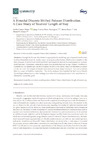Identificador persistente para citar o vincular este elemento:
https://accedacris.ulpgc.es/jspui/handle/10553/107386
| Campo DC | Valor | idioma |
|---|---|---|
| dc.contributor.author | Gómez Déniz, Emilio | en_US |
| dc.contributor.author | Pérez Rodríguez, Jorge Vicente | en_US |
| dc.contributor.author | Reyes, Jimmy | en_US |
| dc.contributor.author | Gómez, Héctor W. | en_US |
| dc.date.accessioned | 2021-06-03T12:23:45Z | - |
| dc.date.available | 2021-06-03T12:23:45Z | - |
| dc.date.issued | 2020 | en_US |
| dc.identifier.issn | 2073-8994 | en_US |
| dc.identifier.uri | https://accedacris.ulpgc.es/handle/10553/107386 | - |
| dc.description.abstract | Although the Poisson distribution is appropriate for modelling equi-dispersed distributions, it reflects bimodality less well. In this paper, we propose a distribution which is more suitable for the latter purpose. It can be fitted to both positively and negatively skewed data and appears to represent overdispersion phenomena correctly in count data models obtained using a Poisson distribution. Furthermore, the distribution can be normalised in terms of its mean value, and therefore covariates can be included. Our empirical results are based on tourists’ length of stay in the Canary Islands (Spain), a popular holiday destination. The study analyses data supplied by the Canary Islands Tourist Expenditure Survey. Our findings show that the model presented is valid and that the fit obtained is reasonably good. | en_US |
| dc.language | eng | en_US |
| dc.relation | Aportaciones A la Toma de Decisiones Bayesianas Óptimas: Aplicaciones Al Coste-Efectividad Con Datos Clínicos y Al Análisis de Riestos Con Datos Acturiales. | en_US |
| dc.relation.ispartof | Symmetry | en_US |
| dc.source | Symmetry [ISSN 2073-8994], v. 12(3), 442, (Marzo 2020) | en_US |
| dc.subject | 530202 Modelos econométricos | en_US |
| dc.subject | 531290 Economía sectorial: turismo | en_US |
| dc.subject.other | Bimodality | en_US |
| dc.subject.other | Covariate | en_US |
| dc.subject.other | Overdispersion | en_US |
| dc.subject.other | Shifted Poisson distribution | en_US |
| dc.subject.other | Length of tourist stay | en_US |
| dc.title | A bimodal discrete shifted poisson distribution: a case study of tourists’ length of stay | en_US |
| dc.type | info:eu-repo/semantics/Article | en_US |
| dc.identifier.doi | 10.3390/sym12030442 | en_US |
| dc.identifier.issue | 3 | - |
| dc.investigacion | Ciencias Sociales y Jurídicas | en_US |
| dc.type2 | Artículo | en_US |
| dc.description.notas | The research of H. W. Gómez and J. Reyes was supported by MINEDUC-UA project, Code ANT 1755. E.G.D. also acknowledges the Departamento de Matemáticas, Facultad de Ciencias Básicas, Universidad de Antofagasta, Antofagasta (Chile) for their special support, as part of this paper was written while EGD was visiting the university in 2018 supported by MINEDUC-UA project, code ANT1755. | en_US |
| dc.utils.revision | Sí | en_US |
| dc.identifier.ulpgc | Sí | en_US |
| dc.contributor.buulpgc | BU-ECO | en_US |
| dc.description.sjr | 0,385 | |
| dc.description.jcr | 2,713 | |
| dc.description.sjrq | Q2 | |
| dc.description.jcrq | Q2 | |
| dc.description.scie | SCIE | |
| item.fulltext | Con texto completo | - |
| item.grantfulltext | open | - |
| crisitem.author.dept | GIR TIDES- Técnicas estadísticas bayesianas y de decisión en la economía y empresa | - |
| crisitem.author.dept | IU de Turismo y Desarrollo Económico Sostenible | - |
| crisitem.author.dept | Departamento de Métodos Cuantitativos en Economía y Gestión | - |
| crisitem.author.dept | GIR Finanzas Cuantitativas y Computacionales | - |
| crisitem.author.dept | Departamento de Métodos Cuantitativos en Economía y Gestión | - |
| crisitem.author.orcid | 0000-0002-5072-7908 | - |
| crisitem.author.orcid | 0000-0002-6738-9191 | - |
| crisitem.author.parentorg | IU de Turismo y Desarrollo Económico Sostenible | - |
| crisitem.author.parentorg | Departamento de Métodos Cuantitativos en Economía y Gestión | - |
| crisitem.author.fullName | Gómez Déniz, Emilio | - |
| crisitem.author.fullName | Pérez Rodríguez, Jorge Vicente | - |
| crisitem.project.principalinvestigator | Vázquez Polo, Francisco José | - |
| Colección: | Artículos | |
Citas de WEB OF SCIENCETM
Citations
5
actualizado el 08-jun-2025
Visitas
150
actualizado el 04-ene-2025
Descargas
138
actualizado el 04-ene-2025
Google ScholarTM
Verifica
Altmetric
Comparte
Exporta metadatos
Los elementos en ULPGC accedaCRIS están protegidos por derechos de autor con todos los derechos reservados, a menos que se indique lo contrario.
